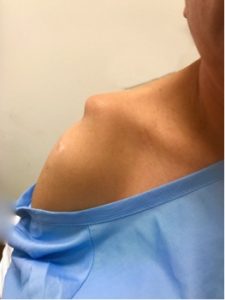AC joint separation recovery time and the return to active sports vary; with the biggest factor being the severity (grade) of the ac joint injury. A careful and precise x-ray evaluation is critical in diagnosing the correct ac joint separation grade. An AC joint injury will either be a minor injury (grade 1 or grade 2), or a major injury (grade 3, grade 4, or grade 5).
Minor injury (Grade 1 or 2)
If the AC joint is sprained but not dislocated the x-ray will be normal or nearly normal. This is a grade 1 or grade 2 AC joint injury, and a quick and full recovery can be expected in a matter of days to weeks. Ice and anti-inflammatory medication can help with the pain and a sling can be used for comfort. The sling can be discarded as soon as the pain subsides, and then either self-directed exercises or formal physical therapy can begin. The focus of therapy is to quickly restore motion and build strength. A full return to sports can be expected once functional movements are restored and the patient is pain-free.
If your recovery progress is slow or even halted, then further work-up and treatment may be necessary. The most likely problem with a poor recovery is that there has been trauma not only to the AC joint, but also to the shoulder joint itself. This is a very common problem, and if shoulder pain persists more than a few weeks then an orthopedic consultation is required to fully evaluate the possibility of other injuries. Most likely this will require an imaging test such as an MRI. In fact, current research confirms that patients with AC separation joint injuries frequently injure structures in the shoulder joint as well. So if you are not recovering well it means that it may be something other than just the AC joint.
Major injury (Grade 3 or higher)

AC joint separation recovery from a major injury (grade 3 or higher) is much more difficult. The first clue if you have a major AC joint injury, other than the severe pain, is that there will be an immediate deformity in the shoulder being a noticeable “bump” which sticks out. This is the end of the collarbone, which is now prominent because the acromion and shoulder blade have detached from the clavicle and is not hanging low. The worse the bump the more severe the AC joint dislocation. The patient in the photo has a very severe grade 5 AC joint separation.
After a careful discussion of risks, benefits, and alternatives, you will then decide if you should or should not have ac joint surgery.
If surgery is not chosen, then the recovery time will take two to three months to achieve a certain level of functionality. Full recovery is often limited with a decrease in range of motion due to the permanent alteration of the anatomy. After the initial recovery phase as outlined above (for low ac joint grade injuries), it will be important to begin a comprehensive rehabilitation program. In particular it is essential to work on scapular stabilization exercises to strengthen the muscles that attach to the scapula. General body conditioning and especially core conditioning is also key to achieving the best results.
If AC joint surgery is chosen, a full recovery will take four to six months. While this is a disadvantage compared to non-surgical treatment, the latest research shows that a successful surgical result restores a higher level of function than can be achieved with conservative treatment. This assumes, of course, a complication-free successful outcome. Many techniques involving pins, screws, plates, and donor tendon grafts have been associated with AC joint surgery complications. Also while the minimally invasive “arthroscopic” technique may seem advantageous it turns out that there is no advantage to this approach and may even cause higher failure rates. So it is essential to choose an AC joint separation procedure such as the Closed Loop Double Endobutton, which is clinically proven to have consistent and better results.
Contact our practice today to schedule your consultation with Dr. Struhl.




